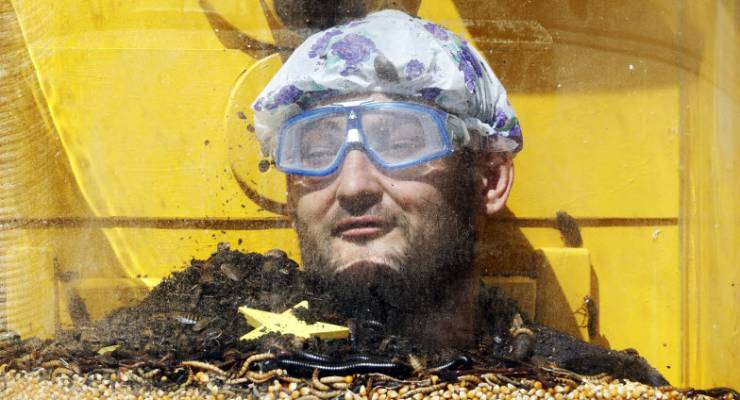
Former footballer Brendan Fevola in Channel Ten’s reality program I’m a Celebrity Get Me Out of Here
Ten Network Holdings has today warned it could collapse, especially if the federal government doesn’t give the network a tax cut and the Murdoch-controlled 21st Century Fox doesn’t renegotiate an onerous programming supply contract.
However, the board, along with auditor Scott Walsh from PwC, has adopted a “going concern” valuation in the hope that favourable outcomes can be achieved on both fronts.
That said, Ten has still written down the television licences by $214.5 million, triggering a net loss of $232 million.
The directors have therefore cut the claimed net assets of the business from $382 million to $152.5 million, even though net debt is only $30 million and the $200 million CBA facility guaranteed by three billionaires has only been drawn down by $40 million.
Ten has 371 million shares on issue, and with the stock tumbling 15% to a record low of 38c in morning trade, its equity is only valued at $141 million, which makes the director valuation look about right.
However, if Ten does collapse — and the increase in trade creditors from $152 million to $195.4 million over the past six months is not a good sign — it will join the long list of companies that claimed they were worth plenty in the final set of accounts released before the undertakers were called in.
As part of the ongoing Crikey Lists series, we today present the first iteration of our list tracking the claimed net assets of public companies at the time of their collapse.
Ideally, you want directors and auditors to be realistic and take heavy write-downs if they really are sailing close to the wind. A good example of a company not on this list is Rubicon America Trust because the directors declared a huge $587 million loss in February 2009 leaving it with negative equity of $142.7 million at the time of its collapse.
Ten is certainly not painting an optimistic figure, but it hasn’t gone all the way to a zero or negative valuation, meaning any subsequent collapse would place it 15th on the following list:
Claimed assets of public companies at time of collapse
Babcock & Brown, $2.63 billion: collapsed in March 2009 but its last audited accounts were released in August 2008 and showed a $150 million half-year profit. Extraordinarily delusional.
ABC Learning, $2.23 billion: claimed this figure in February 2008, but clearly this was more than $3 billion off the mark given the subsequent collapse. The CFO was charged by ASIC and received an 18-month suspended sentence, the auditor was banned for five, years but the chairman of the audit committee, David Ryan, remains on the Lend Lease board to this day.
Pasminco, $1.5 billion: declared a $23 million net profit for 1999-00 and then collapsed shortly after, courtesy of crashing commodity prices.
MFS/Octaviar, $1.22 billion: plunged to a belated $242 million loss for the half year to December 31, 2007, after writing down the MFS Pacific Finance division by $246 million. Collapsed in 2008-09 with a ludicrously optimist book value.
HIH Insurance, $953 million: placed into liquidation on March 15, 2001 and the 1999-2000 annual report claimed net assets of $953 million because it never reported a loss as a listed company.
One-tel, $945 million: collapsed in 2001 and after never declaring a profit or taking a serious write-down.
Brisconnections, $945 million: declared a $142.6 million loss in 2011-12 and then collapsed in early 2013 after traffic forecasts fell massively short.
Sons of Gwalia, $728 million: somehow reported a $12.23 million profit for the six months to December 2003, when this balance sheet claimed net assets of $728 million. Was in administration just a few months later.
Great Southern Plantations, $706.4 million: final result was a $63.8 million loss for the year to September 30, 2008, but it collapsed in 2009 with a grossly optimistic balance sheet.
Timbercorp, $595.6 million: final full-year result was a delusional $44.6 million profit in the year to September 30, 2008, before it collapsed in April 2009.
Allco Finance Group, $545 million: reported a $1.73 billion full-year loss for 2007-08, but this still left it with net assets of $545 million when the administrators were called in.
Rubicon Europe, $298 million: while a big loss slashed its claimed net assets from $537 million to $298.2 million in the 2007-08 balance sheet, the company collapsed shortly after being suspended from trade in November 2008.
ION, $297 million: the car parts company collapsed in late 2004, but the 2003-04 results claimed a net profit of $29.7 million. Administrators were called in on December 7, 2004.
Windimurra Vanadium, $196 million: receivers were appointed in February 2009 with claimed net assets of $196 million in the 2007-08 annual report.
Ten Network Holdings, $152.5 million: declared a $231 million loss for the half year to March 30, 2017, with warnings that it may yet collapse and join this list. The next few months will be critical.
* Stephen Mayne owns one share in Ten Network Holdings, unsuccessfully ran for its board in 2009 and 2014 and has asked questions at its AGMs on six occasions.








Wouldn’t be much of a loss really.
Forgive my ignorance, but how much use is a tax cut when you’re making a loss?
Truth v investor confidence?